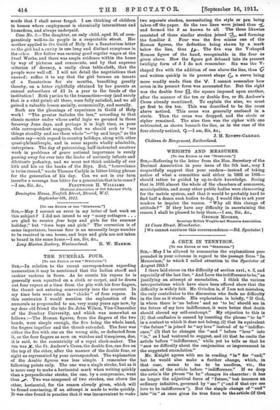THE NUMERAL FOUR.
[To THE EDITOR OP THE SPECTATOR..1 SIR, In relation to the recent correspondence regarding numeration it may be mentioned that the Indian shroff and cashier reckons in fours. As he counts his rupees he is generally seen squatted on a cloth or carpet, and he draws out four rupees at a time from the pile with his four fingers, the thumb not entering conveniently into the account. In my time bets were often in " chicks " of four rupees. In this connexion I would mention the explanation of the numerals as propounded to me, very many years ago now, by my dear old friend the late Dr. John Wilson, Vice-Chancellor of the Bombay University, and which was somewhat as follows :—The Roman figures, from the fingers of the two bands, were simple enough, the five being the whole hand, the fingers together and the thumb extended. The four was either the five with one on the wrong side, or deducted from it, or the four fingers as seen on watches and timepieces, due, it is said, to the eccentricity of a royal clock-maker. The ten was X, the St. Andrew's Cross, the double five, one five on the top of the other, after the manner of the double four, or eight as represented by your correspondent. The explanation of the Arabic figures was less simple. I remember the following points only. The one was a single stroke, but as it is more easy to make a horizontal mark when writing quickly than a perpendicular stroke, the one, by a compromise, went thus 00.. Two was composed of two strokes, one above the other, horizontal, for the reason already given, which will be found convincing, if an attempt is made to write quickly. It was also found in practice that it was inconvenient to make
two separate strokes, necessitating the style or pen being taken off the paper. So the two lines were joined thus
and formed the 2 as known to al]. The three likewise consisted of three similar strokes joined S, and forming the familiar 3. Four was the five minus one of the Roman figures, the deduction being shown by a mark below the line, thus j. . The five was the V-shaped Roman figure of the band, recognisable in the four as given above. How the figure got debased into its present twirligig form of 5 I do not remember. Six was the V-
shaped five with the addition of one above the line, thus
and written quickly in its present shape G, a curve being more readily made than the V. I cannot remember how seven in its present form was accounted for. But the eight was the double four g, the square imposed upon another, after the manner of the ten or double five, or St. Andrew's Cross already mentioned. To explain the nine, we must go first to the ten. This was described to be the cross above noticed. This cross was generally enclosed in a circle. Then the cross was dropped, and the circle or cipher remained. The nine then was the cipher with one subtracted, as shown beneath the line, as in the case of the
four already noticed, am, Sir, &c., J. H. HIYETT-CARNAL.
Château de .Rougemont, Switzerland.










































 Previous page
Previous page